PMI-ACP Certification Overview and Eligibility Requirements

The PMI Agile Certified Practitioner (PMI-ACP)® is a credential for professionals who use Agile in their projects. It covers multiple approaches—Scrum, Kanban, Lean, and XP—and tests how you apply Agile principles on real work, not just terms and definitions. The exam has 120 questions in 3 hours and focuses on four areas: Mindset, Leadership, Product, and Delivery. Use this overview to understand the scope and what the exam measures. Detailed eligibility requirements are provided in the next section; always verify the latest policy on PMI.org.
Why Earn the PMI-ACP Certification?
PMI-ACP helps professionals confirm their Agile skills in a way that hiring managers and clients recognize. It is globally accepted and relevant for common Agile roles in IT, product development, and project work. Below are the main reasons to earn this certification:
- Career AdvantageImproves your chances for promotion, higher-responsibility roles, and client confidence when working on Agile initiatives.
- Verify Skills and ExperienceProvides independent proof that you have real Agile project experience and formal education across multiple approaches.
- Gain Global RecognitionPMI credentials are known and trusted worldwide, making this certification valuable across countries and industries.
- Fill Knowledge GapsPreparation covers Scrum, Kanban, Lean, XP, and other methods so you strengthen weak areas and standardize your Agile approach.
PMI-ACP Eligibility (High-Level)
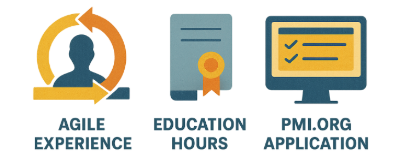
Before you apply, prepare a clear record of your Agile experience and training. For each project, list the organization, project name, start–end dates (MM/YYYY–MM/YYYY), your role (e.g., Scrum Master, Product Owner, Developer, BA, QA), your responsibilities, and the Agile practices you used (e.g., Scrum events, Kanban WIP limits, retrospectives). Sum your total Agile months and ensure dates are non-overlapping. Provide a verifier (manager, sponsor, or client) with name, title, and contact. For education, list each course with provider, title, completion date, and contact hours; keep the certificates. Check PMI.org for the latest eligibility rules, fees, and audit policy before you submit.
- ExperienceList each Agile project with organization, project name, dates, role, responsibilities, and practices used. Indicate total Agile months, avoid overlapping dates, and include a verifier who can confirm your role and timeline.
- Education HoursDocument formal Agile training (minimum 21 contact hours). For each course, record provider, course title, completion date, and hours; keep completion certificates. Sum hours if earned across multiple courses.
- ApplicationWrite 2–4 concise sentences per project: purpose, your role and key contributions, outcomes, and Agile practices applied. Ensure entries are specific, truthful, and consistent with your CV/LinkedIn. Provide verifier details and be ready for audit.
PMI-ACP Exam Focus Areas and Question Format
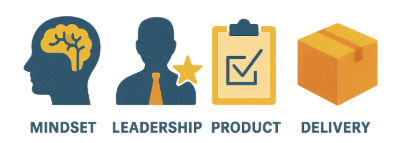
Understand the exam structure before you plan your study. Train in an interface that matches the real test so you reduce surprises on exam day and build reliable pacing.
- QuestionsThe exam contains 120 computer-based questions. Most are situational multiple choice; some may require selecting more than one correct answer.
- TimeYou have 180 minutes to complete all questions. Use full-length timed practice tests to build stamina and keep an average of about 75–90 seconds per item.
- Approach MixQuestions draw from several Agile methods and team contexts, including Scrum, Kanban, Lean, and XP. Be ready to apply principles across different ways of working.
Core Focus Areas (High-Level)
The PMI-ACP exam is organized around four practical focus areas. You should study each one and practice related questions so that no topic is left weak.
- MindsetCovers Agile values and principles. You need to understand how Agile thinking guides decisions, supports transparency, and promotes continuous improvement and collaboration.
- LeadershipFocuses on how to guide Agile teams. Includes facilitation, stakeholder engagement, conflict resolution, team coaching, and removing blockers so the team can deliver.
- ProductCenters on delivering value to the customer. Topics include creating and managing backlogs, prioritizing work by business value, planning releases, and using feedback to adjust direction.
- DeliveryAddresses how work flows through the system. You will practice identifying problems early, tracking flow metrics such as cycle time, maintaining quality, and running retrospectives for improvement.
Step-by-Step PMI-ACP Exam Study Plan
Plan your preparation as a simple cycle: learn the material, practice with questions, review your results, and improve weak areas. If you need structured training and support from trainer/teacher, you can take a course to earn the required education hours; if you choose self-study, do not worry it is also simple how you can study, follow the steps below and keep scheduled goals realistic.
- 1Complete the required Agile education hours through an on-demand or instructor-led course, and keep the completion certificate.
- 2Choose core study materials: the Agile Practice Guide and one current PMI-ACP prep book that includes practice questions.
- 3Create a weekly study schedule with consistent 45–90 minute blocks and define a specific topic to finish each week.
- 4Use a realistic exam simulator and take timed 120-question practice tests to build pacing and endurance.
- 5Practice every week and review explanations in detail. Track performance by focus area and time per question to guide your next sessions.
- 6When your practice results are stable, complete the PMI application, verify eligibility details, and schedule the exam with Pearson VUE.
- 7Prepare for exam day by reviewing policies, running the online system test if applicable, arranging your test environment, and resting well.
1) Complete the required Agile Training (Education Hours Required)
You have to select a course that grants the needed Agile education hours and covers core topics across Scrum, Kanban, Lean, and XP. Prefer up-to-date content with practice questions and downloadable notes.
- PMI & Authorized PartnersOfficial or ATP courses align with PMI’s outline and provide completion certificates.
- On-Demand CoursesAffordable, self-paced options on reputable platforms. Verify recency and learner reviews before enrolling.
- Proof of CompletionSave the certificate; you may need it for application audit. Track course dates and provider details.
2) Choose Your Core Study Materials
Select a small, current set of sources and use them consistently. Start with the Agile Practice Guide and one PMI-ACP prep book that matches the latest exam outline. Add targeted readings only when you need more depth on a topic.
- Agile Practice GuideUse this as your primary reference for Scrum, Kanban, Lean, and XP. Read it end-to-end, highlight definitions, and note examples you can apply on the job.
- PMI-ACP Prep BookChoose a reputable, up-to-date book that aligns with the current exam. Work through chapters in order, complete end-of-chapter quizzes, and record mistakes for review.
- Targeted Deep DivesIf a topic is less familiar (e.g., Kanban flow metrics, XP engineering practices, Lean waste), read only those sections from an additional source to close the gap.
3) Make a Weekly Plan You Can Keep
Your plan should be realistic, consistent, and flexible enough to handle busy weeks. Most candidates do well with two to three study days per week, focusing on one topic area at a time. Each week should include short learning sessions, quizzes, and one longer review session. If your schedule is very tight, scale back the target rather than skipping study completely — small, steady progress is more effective than cramming later.
- Set a Weekly TargetChoose one theme or focus area (e.g., Mindset or Product) for the week and aim to complete all reading and practice questions for that topic before moving on.
- Plan Study BlocksBlock out 45–90 minutes per session on two or three fixed days. Use calendar reminders or phone alarms. If your week is busy, shorten sessions to 30 minutes but keep them consistent.
- Use a Learning SequenceFollow a repeatable pattern: watch or read lessons first, take notes, then attempt quizzes. Afterward, review every explanation (correct or wrong) and write down what to improve next session.
- Adjust for Busy WeeksIf work or family schedules are heavy, reduce the number of topics rather than skipping study. Even a single 30-minute quiz session keeps momentum and prevents forgetting.
- Schedule Review DaysUse one weekend session (or your free day) to review notes and take a timed mini-mock exam. This builds exam stamina and shows whether the week’s learning is sticking.
4) Use a Simulator That Feels Like the Real Exam
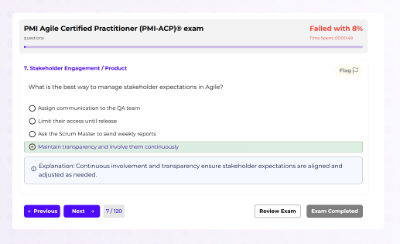
A good simulator builds pacing and confidence. Look for timed full tests, question review with explanations, and analytics by focus area.
- Real TimingRun full 120-question tests with a visible countdown and review mode.See timing in the interface
- Fresh SetsRandomized questions and shuffled answers prevent position memorization.Randomization & shuffling
- Progress TrackingScore trends, focus-area performance, and time per question guide your next week.See progress analytics
- Free DemoAlways test drive first to check speed, clarity, and question quality.Start the free PMI-ACP demo
5) Practice Regularly and Track Your Progress
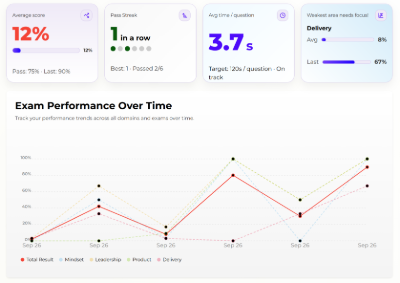
Practice often and review your results. Do short exams on weekdays and a full exam on the weekend. Read every explanation, write your mistakes, and use the data to plan what to study next. Keep your average time near 75–90 seconds per question so you have time to review flagged items.
- Weekday Short ExamsTake 15–30 questions on one focus area (Mindset, Leadership, Product, or Delivery). Use a timer. After the exam, read all explanations and write 2–3 key points you learned.
- Weekend Full ExamTake a 120-question timed exam without pauses. Use mark-for-review. Try to finish in 150–165 minutes so you have time to check flagged questions.
- Target ResultsShort exams: aim for 75%+ and ≤90 seconds per question. Full exams: aim for 70–75%+ overall and keep fewer than 10% of questions over 2 minutes.
- Mistake LogKeep a simple table: question/topic, your answer, correct answer, reason, and rule you missed. Read this log before the next study session.
- Use Your AnalyticsAfter each full exam, check scores by focus area and time per question. Study your two weakest areas next week and repeat one short exam on your slowest topic.
- Spaced ReviewReview missed questions the next day and again after 3–4 days. Make 5–10 flashcards for ideas you miss often (for example, Kanban flow or backlog priority).
- Pacing PlanFirst pass: if you are unsure after ~45 seconds, mark the question and move on. Second pass: return to flagged items. Do not spend over 2 minutes on one question.
- Retake PlanDo not retake the same full exam right away. First, do two short exams on your weak topics. Then take a different full exam or a shuffled pool.
- Ready to ScheduleYou are ready when your last 2–3 full exams are 75%+ overall, no focus area is below 70%, and you finish with at least 10–15 minutes left.
6) Apply on PMI.org and Schedule Your Exam
Create a PMI account, complete the application with experience and education, submit, then schedule with Pearson VUE.
- Start applicationBegin on PMI.org and follow instructions.PMI-ACP certification page
- Fees & policiesReview fees, reschedule rules, and ID requirements.Policies & handbooks
- Schedule examPick a date/time at a center or online.Schedule with Pearson VUE
- Online system testRun the system test on the same device/network you’ll use.Run OnVUE system test
7) Prepare for Exam Day
Reduce surprises: know the rules, set up your space (for online), and rest well the night before. Have a pacing plan and stick to it.
- PoliciesRe-read PMI/Pearson VUE exam rules, ID requirements, and break policy.
- LogisticsIf testing at a center, arrive early. For online, clear your desk and ensure a quiet room.
- MindsetStay calm, read carefully, eliminate wrong choices, flag uncertain items, and keep moving.
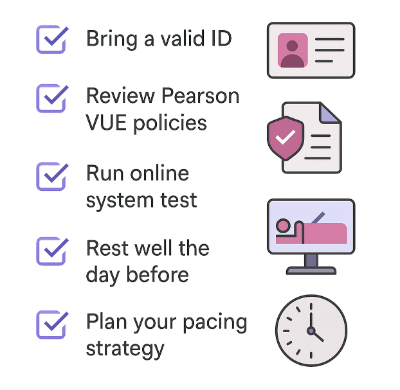
Sample 8-Week PMI-ACP Study Plan (Adjust as Needed)
Follow this plan step by step. Change the days if you are busy, but keep the same pattern: learn, do short exams, review, and take a full timed exam on weekends.
- Week 1Set up. Confirm eligibility and education hours. Read the Agile Practice Guide introduction. Make a weekly schedule (2–3 study days). Take one short exam (15–20 questions) to see your starting level.
- Week 2Mindset. Study Agile values and principles. Do two short exams (15–30 questions each). End the week with a 45–60 minute short exam. Review every explanation and write 5 key notes.
- Week 3Leadership. Study facilitation, stakeholders, conflict handling, coaching. Do two short exams. Take one 45–60 minute short exam on Leadership topics. Update your mistake log.
- Week 4Product. Study value delivery, backlog, prioritization, release planning. Do two short exams. If your timing is stable, take your first full timed exam (120 questions). Review results by focus area.
- Week 5Delivery. Study execution, flow, problem detection, metrics (cycle time, throughput), retrospectives. Do two short exams. Take one full timed exam on the weekend. Compare pacing to Week 4.
- Week 6Close gaps. Use analytics to pick your two weakest areas. Do three short exams focused on those areas (15–30 questions each). Take one full timed exam and check improvement.
- Week 7Exam rehearsal. Take one full timed exam in a quiet room. Use mark-for-review and pacing rules. Review every explanation. Make a one-page summary of rules you often forget.
- Week 8Light review. Read your notes and mistake log. Check PMI/Pearson rules and run the online system test if needed. Sleep well. Take the exam with your pacing plan.
Conclusion: Keep It Simple and Practice Like the Real Exam
If you choose self study, do not forget it is not hard work that you can do id, belive yourself and follow a plan you can keep. Practice in an exam-like simulator, review every result, and let analytics drive your next step. When your recent mocks are consistently strong with time left to review flagged items, schedule the real exam with confidence.
- Practice in real conditionsUse timers, navigator, mark-for-review, and post-exam explanations.
- Cover all focus areasBalance Mindset, Leadership, Product, and Delivery across study and practice.
- Learn from your resultsScore trends and pacing data show exactly what to improve next.
